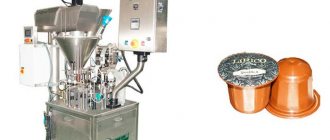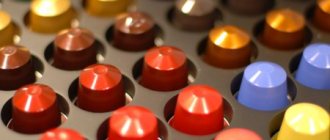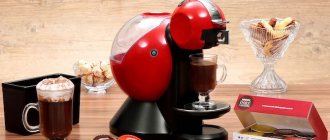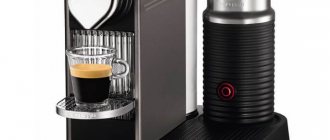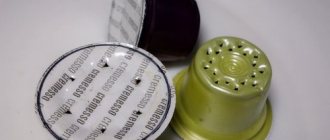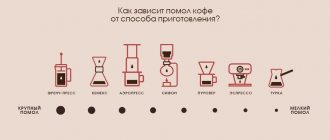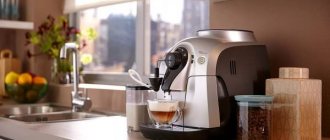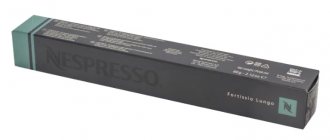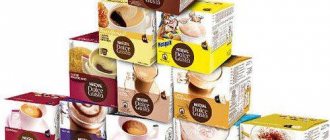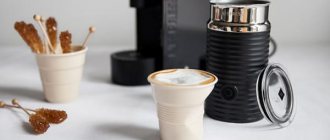If you are a passionate coffee fan and cannot imagine the morning without this hot drink, then, of course, you know how to prepare it perfectly. However, there is not always enough time to fuss around the stove, but you want something tasty - so what to do?
A capsule coffee machine comes to the rescue - a device that prepares coffee on its own, requiring a person only to monitor the cleanliness of the machine and select the correct capsules.
What are capsules and their composition
Externally, a coffee capsule looks like a small glass with a lid, made using a special technology. Inside there is coffee: roasted, ground and pressed.
In one glass - 1 serving of approximately 7-9 grams. The capsule is inserted into a special compartment in which punctures are made on both sides: on one side, boiling water is supplied under pressure, on the other, the finished drink is filtered.
A coffee maker requires much more human attention: it is necessary not only to insert a capsule or pour in ground coffee, but also to correctly form a coffee tablet, remove the grounds and clean the filter.
What are capsules
First, let's figure out what capsules are and what they are. They are small cups with a lid containing roasted, ground and pressed coffee. They are made from different materials:
- Made of aluminum. Quite popular capsules made from aluminum foil by most manufacturers. Foil protects the resulting drink well from the effects of metal. Such packaging is often used for repeated brewing of coffee, the so-called reusable capsules.
- Plastic or polymer products, environmentally friendly.
- Combined, using polymer materials, aluminum foil and cellulose.
The operating principle of capsule-type coffee makers
Before purchasing, it is recommended to carefully study how the capsule coffee machine works. It has its own characteristic features that must be taken into account during daily use.
The action of these devices is based on the use of special capsules, made in the form of small containers filled with different types of ground coffee. Thanks to hermetically sealed packaging, the taste of the product is preserved for a long time.
Capsule-type coffee makers operate as follows:
- Cold water is poured into the tank. It is recommended to use purified bottled water.
- The capsule is placed in a special compartment.
- After pressing the button, the preparation of the drink starts. In expensive models, it is possible to further configure the desired mode.
- The capsule is pierced with a hollow needle, through which water flows inside under pressure, heated to the desired temperature.
- The coffee begins to brew and the finished drink is gradually collected in the container. To avoid premature cooling, heating is equipped.
Many coffee machines are equipped with a built-in cappuccino maker, which allows you to prepare drinks using frothed milk.
Pros and cons of capsule coffee machines
- Capsule coffee machines are cheap: cheaper than other coffee machines. There are, of course, premium devices that cost tens of thousands of rubles, but these are exceptions;
- Capsule coffee is always of the same quality and quite decent. The quality control systems of modern factories do not sleep, so when you pour a drink into a cup, you will get exactly the taste you expect. There is no need to bother with finding decent beans of normal roasting and grinding them: you just need to buy capsules and a good result is guaranteed;
- Capsule coffee machines are easy to operate, and the influence of the human factor on the final result is excluded. A cheap capsule coffee maker is controlled by literally one or two buttons and prepares a cappuccino with thick foam or a three-layer latte in just a minute - something cannot be spoiled no matter how much you want;
- The range of capsule drinks is very wide: there are dozens of varieties of coffee, cocoa, and tea.
Unfortunately, there were also some downsides:
- high cost of operation: the low price of coffee machines is more than offset by the price of capsules. They are disposable and not very cheap. In a couple of years, cheap capsule and expensive geyser coffee machines will be equal in cost;
- The range of drinks is wide, but not endless, and each coffee machine can only load one specific type of capsule. And unlike regular coffee, you most likely won’t be able to buy capsules at the convenience store on the corner: they are not sold everywhere.
In principle, both of these disadvantages can be overcome by using capsules from third-party manufacturers. There are even reusable capsules into which ground coffee is filled, but washing them after each use is still a pleasure, although the savings are very decent.
What types of capsule coffee machines are there?
- Types of capsules . Our stores offer capsule coffee machines from three main brands: Nespresso, Dolce Gusto and Tassimo. There is no fundamental difference between them. The choice is a matter of taste, but you have to make it, because a capsule coffee maker for Nespresso will not digest, say, Tassimo. Just focus on the types of drinks offered in stores under different brands and choose what you like best.
- Operating pressure . A key indicator for all other types of coffee makers, which does not play any role for capsule coffee machines. Capsules of each variety are designed for their own pressure: for Tassimo it is 3.3 bar, for Dolce Gusto - 15 bar, and for Nespresso - as much as 19 bar. Both cheap and expensive coffee machines for compatible capsules produce exactly the pressure they need. So, don't bother yourself with technical details.
- Material . Most coffee machines are made of plastic with metal parts. Premium devices may have an all-metal body, but they also cost accordingly.
- Water tank volume . Usually, cheaper coffee machines have a small water tank volume: somewhere from half a liter. This is enough for home use, but for an office it is better to choose a more spacious option.
Reusable: an alternative for the budget conscious
A significant disadvantage of disposable capsules is the cost. Reusable containers help solve this problem.
Operating principle:
- the lid opens, unlike a disposable container, which is sealed hermetically;
- ground coffee is placed inside;
- pressed - there are special tempera for ease of compaction;
- the lid closes;
- fits into the coffee machine compartment for preparing a drink;
- At the end of the process, the container is not thrown away, but reused.
Containers are made from high-quality plastic or stainless steel. Withstands from 30 to 100 times of use depending on the manufacturer. The cost varies from 150 to 1700 rubles.
The main advantage is efficiency.
However, there are disadvantages.
- The basic principle is violated - storing the product in an airtight package, which makes the drink as rich and aromatic as possible.
- Refillable tanks are often made by third-party manufacturers, and any damage to the machine caused by their use will not be covered by the warranty.
Using reusable containers is much more economical than disposable capsules.
Capsulin
A popular product of the French brand of the same name. The containers are made of plastic and covered with foil on top. Designed for use in Nespresso systems. The cooking technology remains the same, with the exception of filling the container yourself - this makes it possible to individually form your preferred blend, for example, by adding spices.
Emohome
The brand makes capsules for Nespresso from food-grade plastic. 1 container is used up to 30 times. Not suitable for use in coffee machines manufactured before 2003; in systems from 2010, you must put a silicone ring on the container, which is included in the kit.
Coffeduck
The most popular among reusable capsule brands. Produces empty Nespresso containers from food-grade plastic. To choose the right product, you need to know the year of manufacture of the coffee machine - black containers are used from 2010, brown containers are used before 2010.
Mycap
The capsules are suitable for Nespresso. They have a special side design for more efficient foil tension and holes at the bottom. These distinctive features give a richer taste and aroma.
Sealpod
A brand that produces containers for Nescafe Dolce Gusto, made of silicone and steel. The set includes 100 paper filters, 1 capsule and a dispensing spoon. The refueling scheme is quite labor-intensive, which can be considered a design inconvenience.
The Sealpod brand produces reusable capsules made of stainless steel.
Compatible with coffee machines from different manufacturers
Many coffee devices have the ability to use different capsules. For example, reusable capsules for Nespresso coffee machines are now being produced that can be used several times. They are safe and environmentally friendly, although they are made of plastic. Nespresso coffee machine manufacturers have the widest selection of capsule products. They have a large assortment - 16 types of coffee, including 7 varieties of espresso and several decaffeinated options.
Moreover, all these capsules are universal and can be suitable for cars:
Similar capsule products are produced by other manufacturers, for example:
- Capsule products for the Cremesso coffee machine are offered to customers in 11 options, among which the most unusual is coffee with the aroma of spices.
- For Dolce Gusto machines, 14 types of capsules are produced for making Macchiato and Latte type coffee. As well as capsule products with cocoa and tea.
- Tassimo capsules are perfect for machines manufactured by Bosch. They are produced not only with coffee, but also with tea and cocoa.
- Reusable capsules for Tassimo coffee machines are also very popular. They can be purchased both on special Internet resources and in regular supermarkets.
Capsules for Dolce Gusto coffee machines are popular among consumers. They are distinguished by their low cost, which, however, does not affect their quality. They are universal and can even fit Delonghi coffee machines. Dolce Gusto capsules are often called budget capsules. They are produced by Nescafe. These capsules contain 6 g of coffee (instead of the required 7 g), and they are produced in a fairly large assortment:
- Espresso – 10 variations.
- Coffee with milk – 6 variations.
- Decaffeinated – 1 option.
Compatibility of capsules with coffee makers of different brands
Most capsules are not designed for third-party devices. However, some containers were originally designed to be compatible with existing capsule systems. Or the manufacturer, along with his brand's product line, created kits for machines on the market.
The most common systems that third party brands produce compatible products with include Nespresso and Dolce Gusto.
Suitable capsules for Nespresso equipment:
- Starbucks Nespresso;
- Porto rosso espresso;
- L'Or;
- LaCapsula;
- Squesito;
- Di Maestri Nespresso;
- Jardin;
- Bialetti Nespresso.
The following containers are suitable for Dolce Gusto devices:
- Delonghi;
- Di Maestri Dolce Gusto;
- Oysters;
- Squesito Dolce Gusto;
- Starbucks Dolce Gusto.
How to brew without a coffee machine
If you get your hands on a coffee capsule, but the machine is missing (or broken), allow yourself to conduct a fun experiment and brew it without a device. Remove the cap from the capsule. Make a semicircular cut on the plastic; just pierce the foil with a needle and pry it off with a knife.
Further actions depend on what you have in your home: a Turkish coffee maker or a geyser coffee maker. If you have a Turk, pour coffee into it, pour in water (no more than 35 ml for espresso), put it on the stove and wait for the liquid to boil.
Make sure the foam doesn't run away ! Pour a teaspoon of cool water into the prepared drink - this will allow the grounds to settle.
The geyser coffee maker should be disassembled, pour water into the lower container (not higher than the mark), pour coffee into a special filter , put the device back together and plug it in (or put it on the stove). After waiting for the sizzle, turn it off and enjoy the taste.
Which capsules are suitable for different coffee machines?
As mentioned earlier, when choosing containers, you should evaluate them to suit your coffee maker. Thus, Bosch brand equipment can only work with Tassimo capsules, Tchibo - with Clafissimo, Lavazza - with Lavazza, Paulig - with Paulig Cupsolo, Cremesso - with Cremesso. Nespresso appliances and selected models from the Krups and KitchenAid brands welcome Nespresso containers. And devices from Krups Dolce Gusto and Delonghi are designed to use Dolce Gusto tablets.
Advantages and disadvantages of reusable capsules
Among the many positive qualities, the following stands out:
- They are economical.
- You can experiment on your own by adding different types of coffee or cocoa to them.
- Reusable capsules are usually compatible with coffee machines from various brands.
- The coffee inside is protected by an airtight lid, therefore the taste and aroma are preserved longer, and the drink turns out rich and strong.
- Reusable capsules cannot be cleaned or washed. After their service life has expired, they are simply thrown away.
- Coffee using them brews faster and turns out much tastier than usual.
Benefits of brewing coffee using capsules:
- In the first place, of course, is the quality of the drink, since the coffee inside them is all the same grind. The machine maintains the appropriate dosage and heating temperature of the water, which improves the taste of the drink.
- Brewing this coffee is easy and simple. You just need to place the capsule in a special compartment and indicate the necessary parameters for its preparation.
- There is no need to clean them after use; you can simply throw them away.
- The entire process is virtually silent.
- The prepared drink retains the taste of fresh ground coffee, since the “cups” are distinguished by their tightness.
The disadvantages include:
- high risk of breaking the coffee machine needle due to the dense membrane;
- the drink turns out unsaturated and liquid;
- It is difficult to find a container on sale that is suitable for your coffee maker.
When choosing capsules, you need to pay attention to their brand; it is advisable that they be from the same company as the coffee machine.
Supermarkets often hold presentations of coffee drinks from different manufacturers, where you can try different flavors for free and decide for yourself which manufacturer’s range you like best.
Capsules come in different types. Their tightness helps preserve the aroma and taste of coffee for a long time, and the amount of coffee powder in them always depends on the specific recipe of the drink. The proportions are usually designed in such a way that one capsule is intended for one serving of coffee.
Manufacturers are now producing capsule products containing not only coffee drinks, but also cocoa, hot chocolate, and elite varieties of tea.
Features of the use of capsules
Despite the fact that capsules for coffee machines are structurally similar, they are produced under certain brands, for example, Nespresso, Dolce Gusto, Lavazza. Therefore, often cups from one brand do not fit into capsule systems from another brand.
Containers from different manufacturers vary in shape and size, but are installed in the device according to the same principle.
Compatibility of capsules of different brands
The manufacturer is trying to solve the problem in several ways. The first is the possibility of using not only original capsules in coffee makers, but also cups from other manufacturers.
Alternative capsules
The largest number of alternative containers are suitable for Nespresso systems: Smart Coffee Club, MUST, EGOISTE, Julius Meinl, Café Royal, Kaffa, Professo, Porto Rosso, Musetti, RIOBA (Metro CC brand).
Even the Russian one offers 3 types of coffee, which are sold in chain stores such as Auchan and Lenta.
Domestic Oysters containers are compatible with Dolce Gusto.
But for Cremesso and Tassimo machines there are no substitutes for their containers on the Russian market.
Alternative cups are often cheaper than the original ones. The coffee preparation time is the same for all containers. The disadvantages of non-original capsules are deterioration in the quality of the drink and increased scale formation.
Reusable capsules
The second way to reduce the cost of capsule coffee is to use reusable cups.
The most famous manufacturers of reusable capsules are Coffeeduck, which offers empty containers for NESPRESSO devices, as well as Capsul'in and MY Cap. The set they sell with plastic cups includes a dispenser and sheets with self-adhesive lids.
Sealpod offers reusable containers for DOLCE GUSTO. The set includes one cup, 100 filters and a measuring spoon.
Important ! Reusable containers also have a usage limit, after which they are disposed of.
Consequences of using non-original capsules
Saving on original cups does not come without consequences. When using reusable containers, the quality of the drink suffers due to leaky storage of raw materials. The machine quickly becomes dirty with coffee residues. The amount of contents in the capsule is different each time, and the cups require careful cleaning after use.
Types of disposable capsules
The following types of disposable capsules can be found on store shelves:
- Nespresso - suitable for Nestle coffee makers, have about 20 flavors;
- Tassimo - created for Bosch machines that read the barcode from the container and, thanks to the information stored in it, prepare the drink;
- Nescafe - suitable for Dolce Gusto and DeLonghi coffee machines, has a six-gram filling, which is below the standard, and has 20 different flavors;
- Squesito – compatible with Philips and Squesito coffee machines. The product of this manufacturer is distinguished by pure coffee varieties and blends of Arabica and Robusta. It has only six varieties: four types of coffee, hot chocolate and decaffeinated coffee;
- Lavazza - work exclusively on Lavazza devices. The container contains 7.5 g of coffee; the line includes six types of espresso and several types of mixed coffees;
- Cremesso - suitable for Cremesso and Philips coffee machines; two types of beans are used for their production: robusta and arabica. The manufacturer keeps the recipe secret. The Swiss company Delica, which promotes Cremesso coffee machines, controls the entire production process, from growing coffee on plantations to the exit of the drink from the machine.
Attention ! Before purchasing a product, find out which manufacturer's capsules are suitable for your coffee machine.
Alternative Nespresso capsules
There are many manufacturers of similar capsules suitable for Nespresso around the world. The most popular are:
- Musetti;
- Pelican Rouge;
- Coffee;
- Julius Meinl;
- Elite coffee collection;
- Rafael Conde;
- Moscow coffee shop on shares.
The cost of a set of 10 capsules from a similar manufacturer will cost only 200-400 rubles, which is significantly cheaper than the original ones.
The use of alternative coffee containers for a capsule machine does not mean that the quality of the beans in it is poor. Some consumers note in their reviews that they practically do not notice the difference between the original product and its high-quality replica. The only important nuance that you should pay attention to when purchasing a non-original capsule is whether this container is suitable for your particular coffee machine model.
Reusing Empty Containers
Due to the high price of coffee capsules, you've probably wondered if they can be reused. There are several ways to do this. Let's take a closer look at one of them.
This procedure will require the following materials:
- empty capsule;
- lighter;
- screwdriver (you can use a drill);
- wood drill bit No. 8;
- brake cylinder fitting cap for VAZ.
Attention ! Before starting work, rinse the caps thoroughly under running water.
Let's get started:
- Using a drill, make a hole behind the container label.
- We rinse all containers with warm water and let them dry thoroughly.
- We heat the blunt side of the drill with a lighter and melt the hole it makes to such a size that it can be tightly closed with a cap.
- Using a paper funnel, add ground coffee (about 2 teaspoons).
- Close the hole with a cap.
The capsule is ready for reuse.
Attention ! When working with a drill, do not damage the membrane and barcode on the container, otherwise the capsule will not work.
Capsules for Dolce Gusto coffee machines
Dolce Gusto capsules are notable, firstly, for their large selection of drinks (including hot chocolate, cold cappuccino), and secondly, for their greatest distribution in retail stores. They are sold even in small convenience stores, not to mention all sorts of supermarkets, hypermarkets and other chains.
The taste of coffee from these capsules, in my opinion, is inferior to Nespresso capsules. Yes, the system allows you to make milk-coffee drinks on any coffee machine in its system, but such drinks use powdered milk as a base. In addition, some drinks - Mocha, Cortado, Coffee with milk, Cappuccino Ice - contain not ground, but instant coffee (I marked such completely unnatural capsules with a ⚠ icon), plus, among other things, stabilizers and emulsifiers. Stabilizers and emulsifiers are contained, in principle, in almost all capsules with a milk component.
Dolce Gusto capsules are sold in 16 pieces per package. But you need to understand that milk-coffee drinks are prepared from two capsules, which are sequentially loaded into the coffee machine. Accordingly, such drinks are twice as expensive as black coffee. In the table, in the column “RRP for a drink,” I recalculated the approximate cost of a package of 16 capsules for the corresponding number of drinks received: 16 for “black” varieties, 8 for milk-coffee capsules. The price was taken as “recommended retail”, the current ones are from the links.
Each capsule has a schematic scale for the recommended volume of the drink. The same scale is available on some coffee machines of the system, with an auto-dosing function. You mark the level on the machine, and it will pour as much as is intended to correspond to the best taste. It is clear that you are free to set any level of the drink according to your preferences, in addition, on some machines of the Dolce Gusto system, the serving is, in principle, completely manual.
Below is a list of branded varieties as of the beginning of 2021:
| Photo | Name | Compound | Description | RRP for drink |
| Espresso (Espresso) | 16 capsules: natural ground coffee, dark roast | Classic espresso | 24 ₽ | |
| Ristretto (Espresso Ristretto) | 16 capsules: natural ground coffee, dark roast | Classic ristretto – small volume espresso | 24 ₽ | |
| Ristretto Ardenza (Ristretto Ardenza) | 16 capsules: natural ground coffee, dark roast | An especially strong and rich ristretto with nutty notes. The most tart in the line of Dolce Gusto flavors | 24 ₽ | |
| Barista (Espresso Barista) | 16 capsules: natural ground coffee, dark roast | Strong and rich espresso | 24 ₽ | |
| Espresso Intenso (Espresso Intenso) | 16 capsules: natural ground coffee, medium roast | Full-bodied espresso with nutty and fruity notes | 24 ₽ | |
| Espresso Caramel (Espresso with caramel flavor) | 16 capsules: natural ground coffee, dark roast, natural flavor (caramel) | Espresso flavored with caramel | 24 ₽ | |
| Grande | 16 capsules: 100% ground Arabica medium roast | A large cup of coffee, richer than a classic Americano | 24 ₽ | |
| Grande Intenso | 16 capsules: 100% ground dark roasted Arabica | A big cup of even stronger coffee | 24 ₽ | |
| Lungo | 16 capsules: 100% ground Arabica medium roast | Classic lungo, corresponding to espresso with a double portion of water passed through the coffee tablet | 24 ₽ | |
| Americano (Americano) | 16 capsules: 100% ground Arabica medium roast | Classic, weak Americano | 24 ₽ | |
| Americano Smooth Morning | 16 capsules: ground Arabica from Brazil, Colombia and Honduras + Robusta from Vietnam, medium roast | Americano with caramel notes. The implied volume is 300 ml. | 24 ₽ | |
| Mexico Americano | 16 capsules: ground Arabica and Robusta medium roast from Mexico | Americano with notes of hazelnuts and plums | 32 ₽ | |
| Colombia Lungo | 16 capsules: 100% medium roast ground Arabica from Colombia | Lungo with notes of toasted almonds, nutmeg and barley | 32 ₽ | |
| Peru Espresso | 16 capsules: 100% medium roast ground Arabica from Peru | Strong espresso with notes of wood, licorice, pepper, black currant aftertaste | 32 ₽ | |
| Honduras Espresso | 16 capsules: 100% medium roast ground Arabica from Honduras | Smooth espresso with notes of honey, dark chocolate and malt | 32 ₽ | |
| Cappuccino (Cappuccino) | 8 capsules: natural ground coffee, dark roast, 8 capsules: whole milk powder, sugar, emulsifier | Classic cappuccino based on an espresso shot | 48 ₽ | |
| Cappucino Intenso | 8 capsules: ground Arabica from Ethiopia and Brazil + Robusta from Vietnam, dark roast, 8 capsules: skimmed milk powder, sugar | Cappuccino with a richer coffee base | 48 ₽ | |
| Latte Macchiato | 8 capsules: natural ground coffee, dark roast, 8 capsules: whole milk powder, sugar, emulsifier | The classic latte macchiato is a layered drink with milk at the bottom, then a layer of espresso, and a cap of delicate milk foam on top. | 48 ₽ | |
| Latte Macchiato Vanilla (Vanilla Latte Macchiato) | 8 capsules: natural ground coffee, dark roast, 8 capsules: whole milk powder, sugar, natural flavor (vanilla), emulsifier | Latte Macchiato, vanilla flavored | 48 ₽ | |
| Latte Macchiato Caramel (Caramel Latte Macchiato) | 8 capsules: natural ground coffee, dark roast, 8 capsules: whole milk powder, sugar, natural flavor (caramel), emulsifier | Latte Macchiato, caramel flavored | 48 ₽ | |
| Cortado Espresso Macchiato (Cortado Espresso with milk) | ⚠ 16 capsules: whole milk powder (61.8%), instant coffee (36.5%), stabilizers (potassium phosphates and sodium citrates), emulsifier | Instant coffee with milk powder | 25 ₽ | |
| Café au Lait (Coffee with milk) | ⚠ 16 capsules: whole milk powder (73.7%), instant coffee (24%), stabilizers (potassium phosphates and sodium citrates), emulsifier | Instant coffee with milk powder. Less weak and milkier than Cortado | 25 ₽ | |
| Chococino (Hot chocolate Chococino) | 8 capsules: sugar, cocoa powder (32%), emulsifier, flavoring (vanillin), cinnamon 8 capsules: whole milk powder, sugar, emulsifier | Classic hot chocolate | 48 ₽ | |
| Chococino Caramel (Hot chocolate with caramel flavor) | 8 capsules: sugar, cocoa powder (32%), emulsifier, flavor (vanillin), cinnamon 8 capsules: whole milk powder (50%), sugar (35%), natural flavor (caramel), emulsifier | Hot chocolate flavored with caramel | 48 ₽ | |
| Mocha (Mocha) | ⚠ 8 capsules: whole milk powder, sugar, cocoa powder, instant coffee, emulsifier 8 capsules: whole milk powder, sugar, emulsifier | Thick hot chocolate with coffee notes | 48 ₽ | |
| Nesquik | 16 capsules: whole milk powder (46.1%), sugar, cocoa powder (10.5%), skim milk powder, flavorings, minerals, salt, yeast extract, vitamins, cinnamon | Regular hot Nesquik with airy foam | 25 ₽ | |
| Espresso Decaffeinato (decaffeinated espresso) | 16 capsules: natural ground coffee, medium roast | Decaffeinated espresso | 25 ₽ | |
| Cappuccino Ice (Cold Cappuccino Ice) | ⚠ 8 capsules: whole milk powder (46.5%), sugar (41.7%), instant coffee (10.6%), flavor identical to natural, coconut oil, emulsifier 8 capsules: skim milk powder (39%) , sugar (37.2%), whole milk powder (12.6%), glucose syrup, coconut oil, emulsifier, stabilizer | Cold cappuccino based on instant coffee and milk powder. Served with cold water, this mode is available on coffee machines of the Dolce Gusto system | 48 ₽ |
Analogues of capsules for Dolce Gusto
Alternative analogue capsules for Dolce Gusto are found everywhere in the West; many chain stores produce them under their own brands, such as Auchan. In Russia, alternative Dolce Gusto capsules are less common, but they still exist.
This is, first of all, Must Dolce Gusto (sometimes for simplicity in stores they are simply called MUST DG). This brand produces only six flavors, as far as I know: Neopolitan espresso, decaffeinated espresso, cremoso espresso, Puro Arabica espresso, lungo, ristretto, cappuccino (⚠ milk powder, stabilizer, emulsifier) and hot chocolate. Also, analogues for Dolce Gusto are produced under the brand Di Maestri (here is a small selection from Yandex.Market), Veronese (unreasonably more expensive than the original ones) and Starbucks . Previously, there were also analogues from Oysters , but now I don’t see them anywhere.
The hardworking Chinese also produce reusable capsules for Dolce Gusto. As with Nespresso, they come in three types:
The simplest plastic ones A more advanced generation: plastic, a silicone seal and a little steel The latest achievement of Chinese industry is an all-steel capsule for Dolce Gusto with a complete tamper. Yes, yes, a tamper for a capsule—whatever they come up with!
Benefits of use
The quality of this coffee has long been beyond doubt. In addition to the wonderful aroma and impeccable taste, several more advantages can be noted:
- simplicity and speed of preparation;
- environmentally tested composition;
- variety of drinks.
All advantages apply to both disposable and reusable products. The second option is more progressive and improved, so their use is also economical. They also allow you to experiment with different flavors in your coffee machine.
Cooking features
Anyone can make this drink—no special knowledge is needed.
The brewing process is very simple thanks to the automatic operating principle of the coffee machine. You need two basic steps:
- Insert the cup between two filters where it is pierced. On one side there is a supply of hot water pressure.
- Place the cup on the other side. Coffee will come out of the opposite hole.
Tips for use
Despite the ease of use, some still have questions regarding use. Answers to the most common questions below.
How to post
How to insert a reusable cup for the first time and replace the refiller:
- The container in the coffee machine must be placed so that the loop on the lid is strictly in the center.
- You need to close and open the machine lever again to make sure that the needle has pierced the membrane. If this does not happen, you will need to pierce it manually.
- Finally, you need to check how freely the lid of the coffee machine closes: opening with force means that the hole for the needle is not wide enough.
How to refill
For each subsequent use, you must first install one stainless steel filter, fill the container with refill and secure the second filter. After which the glass should be tightly closed with a lid.
How to use again
Reusable containers should be rinsed, dried, refilled with coffee, and secured with foil.
How to choose
Disposable products must be used to prepare drinks in machines from the same manufacturer. Reusable containers are universal and designed for all compatible devices.
How long
Multiple containers help save money. The service life depends on the brand and manufacturer. For example, one reusable Dolce Gusto is enough for 50–100 cups.
What is Nespresso
The company in question has an original concept, a well-thought-out sales method and a set of activities that promote the brand and support work with clients. The company also has its own club.
The idea for the coffee capsule came from Eric Favre, who was an employee of another company, Nestle. The idea of creating such capsules was invented back in 1975; Favre received a patent for this invention 3 years later, in 1978. A few years later, in 1986, Nestle established the familiar Nespresso company.
The new brand immediately began selling coffee capsules, as well as the C100 machine that printed them. From its inception until 1988, sales were focused only on office businesses, but then sales were allowed to ordinary people. The high price was justified by the fact that buyers were purchasing a premium product.
Nespresso gained popularity, and already in 1989 a special program was created - Nespresso Club. Only those people who purchased the necessary coffee machine could become members of the club.
Capsules and devices for puncturing them are sold by telephone, through company stores, and also through our own website. Initially, only the premium segment was presented, but later the company decided to expand and acquire the mid-price category. The Dolce Gusto system was created especially for this; such capsules can be bought in a regular shopping center.
The capsules themselves are a small cone-type container, the size of which does not exceed the dimensions of a walnut. It must be said that such capsules have no analogues in the world.
The body of the product is made of aluminum, the inside is covered with cling film. This ensures the safety of the coffee beans and does not allow them to come into contact with metal, preventing oxidation. The quality of freshly ground coffee in such a capsule is preserved for 12 months. The design is patented by Nespresso, as is the method of creating the capsule.
Assortment of coffee capsules
Coffee for capsule machines varies in strength, which is rated on a scale from 1 to 10, as well as the type of bean. The most popular are Arabica, as well as a blend with an admixture of Robusta. The general range of drinks includes:
- Classic espresso is used to prepare a small cup of coffee with a volume of 40 ml. The strength of this drink, depending on the grain, can reach 10 points.
- Lungo – designed for preparing a large volume of 110 ml drink. Its taste is softer than espresso, but no less rich.
- Decaffeinated coffee.
- Hot chocolate.
- Tea with mountain herbs.
This way, you can experiment by purchasing different capsules and try new types of coffee without leaving your home.
Nespresso Espresso capsules
Nespresso Espresso capsules are the core of their range of coffee capsules. They showcase a variety of the most popular coffee flavors.
The 7 capsules in the Espresso collection differ in flavor intensity due to the fact that all types of coffee are produced in different places.
Ristretto capsule
Ristretto is a blend of East African and South American Arabica beans. Just a little robusta is added to it. The coffee is roasted individually. The result is a delicate, fruity, sour note that perfectly complements the strong, rich espresso.
By the way, the beans are slowly roasted to obtain a truly intense and original bouquet, the taste of which is reminiscent of chocolate. These capsules use finely ground coffee to create an Italian-style drink.
Approximate cost: $42.99
Arpeggio capsule
Arpeggio Arabica coffee capsules are made from a mixture of beans from Central and South America. They have a malty, fruity flavor characteristic of Costa Rican coffee. Fine grinding helps to better extract the rich flavor.
Arpeggio coffee is strong, with woody notes and a delicate hint of cocoa.
Approximate cost: $41.99
Roma capsule
Roma capsules are a balanced blend of Arabica from Central America and Robusta from Brazil. This coffee has a pleasant, viscous taste.
The beans used to make Roma coffee are lightly roasted and finely ground. Thanks to this, relatively strong espresso gains grace and brightness. The bouquet of taste contains woody notes.
Approximate cost: $42.89
Livanto capsule
Livanto coffee is made from a blend of beans from Costa Rica and Colombia. Coffee is grown there in the traditional way. This is necessary in order to preserve its fruity, malty taste.
The medium roast used to create Livanto enhances the flavor. A delicate, complex, almost caramel bouquet of taste appears with notes of cereals.
Approximate cost: $42.89
Volluto capsule
Volluto is one of our favorite espresso flavors from Nespresso. Volluto is a lightly roasted, cereal-flavored coffee. It is made from a blend of Brazilian and Colombian Arabica beans. This coffee is grown organically on small plantations, following local traditions.
In terms of taste, this coffee is sweet and fruity. The note of bread and cereals is clearly audible.
Approximate cost: $42.99
Capriccio capsule
Capriccio is a blend of South American Arabica beans. The coffee is grown at high altitudes and has a rich flavor with a slight sourness. There is a perfect balance between Brazilian Arabica and a small amount of Robusta. Cereal notes dominate this smooth coffee.
Approximate cost: $16.89
Cosi capsule
Cosi coffee capsules have a light, citrus taste. They make the perfect “light” espresso. It's great to drink mid-morning, perhaps with biscotto.
Cosi is made from a blend of East African Arabica beans. Because of this, easily distinguishable, subtle notes of lemon are obtained. Arabica beans from South and Central America are also added. They add lightness and sweetness to coffee.
Approximate cost: $42.89
